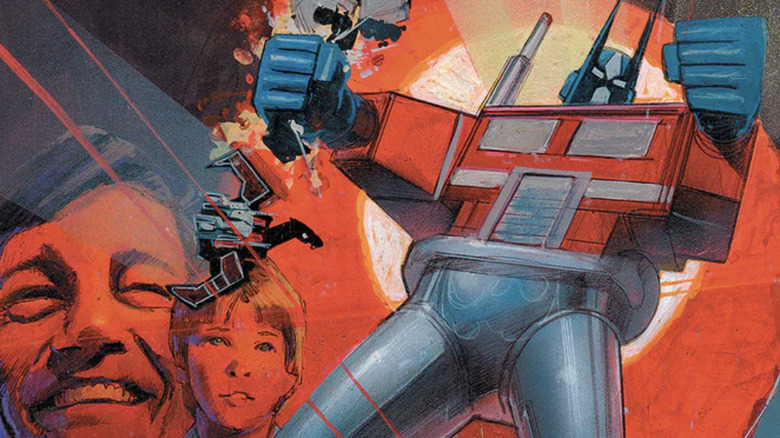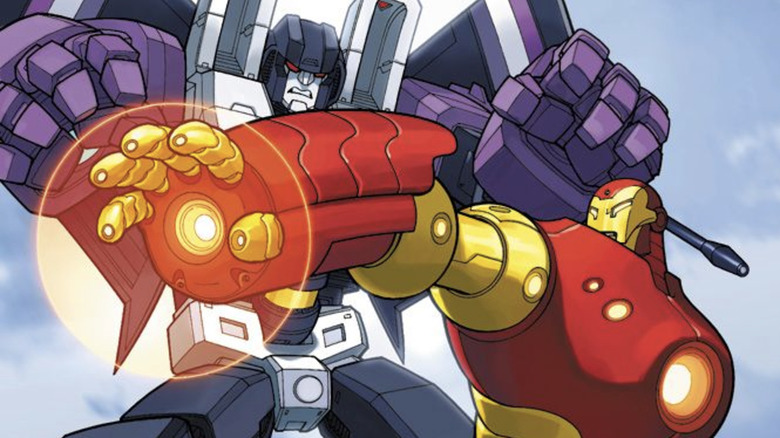Transformers Fans Can Thank Two Marvel Legends For The Robots In Disguise
"Transformers" does not have a singular creator — that's what happens when a story begins for commercial reasons, not artistic ones. During the 1980s, toy giant Hasbro imported several Japanese action figures of transforming robots. The Reagan administration had also loosened regulations on advertising in children's entertainment, so now Hasbro just needed a story to sell these "Transformers."
That call was answered by Marvel Comics, who Hasbro had already partnered with Marvel to develop their "G.I. Joe" series. In 1981, writer Larry Hama was pitching a new Nick Fury series. Then in came Hasbro, who wanted creative input for their planned action figure line "G.I. Joe: A Real American Hero." Marvel's Editor-in-Chief Jim Shooter first suggested the idea of G.I. Joe as a anti-terrorism team, and proposed that Hama fold his ideas for Nick Fury into "G.I. Joe." Cue an ongoing "Joe" comic written by Hama, published by Marvel hitting stands in 1982.
Amusingly, Shooter and co. had to convince Hasbro to include villains in the book, because Hasbro executives (insanely) thought that kids wouldn't buy bad guy toys. (Shooter credits Marvel writer/editor Archie Goodwin for first conceiving of the Joe's terrorist nemeses, Cobra.)
When "Transformers" became Hasbro's next project, Marvel was naturally who they went to. Shooter wrote the original "Transformers" pitch document, outlining the core premise of alien Autobots and Decepticons coming to Earth to fight for resources. (Read Shooter's "Transformers" pitch document here.) He then gave writer Dennis O'Neil first crack at writing character profiles for the 28 toys Hasbro was planning to ship.
Who are Jim Shooter and Dennis O'Neil?
O'Neil (who passed in 2020) is moreso remembered for his work at DC Comics. In the 1970s, he revitalized Batman alongside artist Neal Adams (paving the way for "Batman: The Animated Series"). O'Neil and Adams' "Green Lantern/Green Arrow" comics also introduced the politics of the day to their young readers, but without talking down to them.
Like most prolific superhero writers, O'Neil bounced between the two big publishers. From 1980 to 1986, he was at Marvel and wrote "Iron Man," "Daredevil," and ultimately the original "Transformers" character profiles. Some of O'Neil's contributions endured — most notably, he came up with the name "Optimus Prime" for the Autobots' leader, a red truck/robot toy originally known as "Battle Convoy." Voice actor Peter Cullen brought Optimus to life, but O'Neil drew the blueprint.
However, for whatever reason, Shooter and/or Hasbro didn't like O'Neil's work. Editor Bob Budiansky was recruited to revise the profiles (apparently on a tight deadline).
Jim Shooter was no doubt an impactful figure in American comics, but he's also a controversial one. He'd been working in comics since he was 14 years old, when he mailed in a Legion of Superheroes comic to DC. Shooter's Legion comic impressed editor Mort Weisinger enough to commission more from him, and soon this comic-making superboy was writing Superman. This may sound like a fanboy's dream, but Shooter's audacity wasn't born of naivety. In a 2010 interview, Shooter explained:
"My family needed the money. I was doing this to save the house; my father had a beat-up old car and the engine died – this is before I started working for DC – and that first check bought a rebuilt engine for his car so he didn't have to walk to work anymore. I was doing this because I had to, working my way through high school to help keep my family alive."
Introduced to Marvel Comics at age 12, Shooter thought they were much better than the Distinguished Competition: "I got the idea that if I learned to write like this Stan Lee guy, I could write for these other turkeys, DC, because they sure needed the help." So, when he got the chance, he moved over to Marvel and became editor-in-chief in 1978. There, he gained a reputation for being a controlling editor. In a 1987 deposition, Shooter stated "The author of [X-Men] is Marvel Comics," denigrating the contributions of writer Chris Claremont and artists like Dave Cockrum and John Byrne.
Hasbro wasn't the only toy company Shooter let into the door, either. He wrote the original 1984 "Secret Wars," the first comic "crossover event" that was really an advertisement for Mattel's new Marvel action figures. Marvel and DC have been chasing the sales' high of "Secret Wars" ever since and the effects of constant "events" have been negative.
Transformers and Marvel Comics crossovers
Bob Budiansky's revised profiles were accepted. They became the ones used in Shooter's pitch, published in the comics and toy packaging, and which were passed along to "The Transformers" cartoon writers.
Budiansky's impact on "Transformers" cannot be downplayed; he in essence created the series' original core cast. Dennis O'Neil may have named Optimus Prime, but Budiansky named Megatron. He also renamed the treacherous Decepticon jet from "Ulchtar" to the much more fitting "Starscream." Budiansky said the villain needed a name that "evoked power, menace, insanity, danger, evil" and he succeeded in finding one.
Part of the assignment was coming up with a "motto" for each Transformer, that distilled their personality into a few simple words. In doing so, Budiansky coined Optimus Prime's famous saying that, "Freedom is the right of all sentient beings" and Starscream's less famous but also memorable boast that, "Conquest is made from the ashes of one's enemies."
After "Transformers" issue #1 hit stands, Budiansky once more stumbled into shepherding the series. During the initial four issue mini-series, he was only the editor. When the comic became ongoing, he took over as writer and stayed several more years, departing after issue #55.
The early "Transformers" comics were written like the series took place in the Marvel Universe. Spider-Man guest stars in "Transformers" #3 — the cover (drawn by Mark Texeira) shows Spidey web-slinging around an enraged Megatron.
In "Transformers" #8, the Dinobots get their alternate modes from the Savage Land, a region in the Marvel Universe where dinosaurs still exist in a tropical jungle. As "Transformers" went on and trying to fit it into the Marvel Comics timeline would be too big a chore, that pretense was forgotten. (Though in 2005, Marvel and Transformers came together again for comic mini-series "New Avengers/Transformers.")
"Transformers" has long outgrown its Marvel roots; the current "Transformers" comic from Skybound Entertainment is even beating most Marvel Comics at their own game. Though the Robots in Disguise first arrived to America from Japan, they only transformed into how we know them today thanks to Jim Shooter, Dennis O'Neil, and Bob Budiansky.



